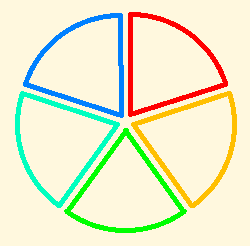What is a Unit?
On Tuesday in class we discussed how one whole unit doesn't necessarily have to be "one."
For instance:
If you eat 1 and 1/2 grapefruits every morning and you have a total of 5 grapefruits and you want to know how many days they will last, you wouldn't find the answer to this problem by dividing 5 by 1. Instead you would find the answer by dividing 5 by 1 and 1/2 since that is the whole unit you are working with.
 | |||
| 1 and 1/2 grapefruits |
This skill is applicable when you are shown part of a picture and told it's a fraction of a whole...
For instance:
If you're told this is 3/4 of the whole, what would the whole be?
 | |||||
| 3/4 of the whole |
This would be the whole: (not at scale)
Next we discussed a basic understanding of fractions and how important it is to explain them to kids correctly. Most of us were taught that if you see a fraction such as 3/5 you should think of it as 3 out of 5. Which is all fine until you get to a fraction like 4/3 which will completely confuse a child because they can't conceptually understand that from the 4 out of 3 explanation.
This is how you should instead explain it:
3/5 should instead be explained as Three 1/5 pieces. That way when you get to fractions such as 4/3 you can explain it as Four 1/3 pieces. This method easier for children to comprehend and unlike the simplistic way is actually something they can apply to more difficult problems as they progress in school.
 | |||
| Three 1/5 pieces would be three of the above sections... |
Big Ideas: Partitioning and Iterating
Partitioning: Splitting the whole into equal parts.
 |
| So if you're told the above rectangle is a whole unit and to find 1/4 you would "partition" it into 4 equal pieces |
| (Image not to scale) your result would be something like this, with the unshaded piece representing 1/4 |
 | |||||||||
| So if you were told the above triangle is 1/3 and you were to find a whole unit you would iterate the triangle three times. |
 | |||||||
| (not to scale) You can see how 3 triangles iterated results in a trapezoid shape. |
Thursday March 28th~
Saying Fractions:
We reviewed as discussed above how to properly say fractions, for maximum comprehension, (3/4 would be three 1/4 pieces)
We then discussed the definition of numerator and denominator:
Numerator: The NUMBER of pieces.
Denominator: The DENOMINATION (size) of the pieces.
For the rest of the class period we did activities that discussed whole units and fractions and their meaning.
Hope this post was helpful! :)

